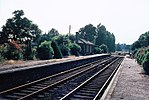Glemsford railway station
Babergh DistrictBeeching closures in EnglandDisused railway stations in SuffolkEast of England railway station stubsFormer Great Eastern Railway stations ... and 4 more
Pages with no open date in Infobox stationRailway stations in Great Britain closed in 1967Railway stations in Great Britain opened in 1865Use British English from April 2017

Glemsford railway station was a station that served the village of Glemsford in Suffolk, England. It opened in 1865 on the Stour Valley Railway between Sudbury and Cambridge. The station and line closed in 1967 as part of the Beeching cuts.
Excerpt from the Wikipedia article Glemsford railway station (License: CC BY-SA 3.0, Authors, Images).Glemsford railway station
Lower Road, Babergh
Geographical coordinates (GPS) Address Nearby Places Show on map
Geographical coordinates (GPS)
| Latitude | Longitude |
|---|---|
| N 52.0868 ° | E 0.6721 ° |
Address
Lower Road
Lower Road
CO10 7UB Babergh
England, United Kingdom
Open on Google Maps











